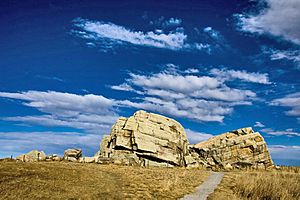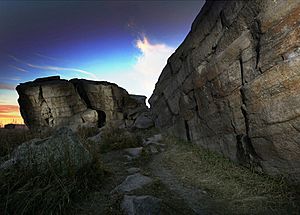Big Rock (glacial erratic) facts for kids
Big Rock is a giant rock that sits on the flat lands of Alberta, Canada. It's also known as the Okotoks Erratic. The Blackfoot people call it Okotok. This huge rock weighs about 16,500 tonnes, which is like 18,200 cars! It's part of a very long line of unique rocks called the Foothills Erratics Train, which stretches for about 930 kilometers (580 miles).
This massive rock is broken into two main pieces. It's about 41 meters (135 feet) long, 18 meters (60 feet) wide, and 9 meters (30 feet) tall. Big Rock is made of a type of rock called quartzite, which can be light grey, pink, or purple. Even though it has cracks from ice and cold, it still looks fresh. You can find Big Rock about 8 kilometers (5 miles) west of the town of Okotoks, Alberta, and 18 kilometers (11 miles) south of Calgary.
Big Rock is a glacial erratic. This means it's a rock that was moved a long way by a glacier. It's part of the Foothills Erratics Train, a 930-kilometer (580-mile) line of thousands of special rocks. These rocks range from small (30 cm or 1 foot) to very large (41 meters or 135 feet). The Foothills Erratics Train runs along the eastern side of the Rocky Mountains in Alberta and northern Montana. The rocks in this train are a type of quartzite that comes from the Athabasca River Valley. Big Rock is the biggest rock in this whole train! Because it's so big and sits on flat land, it was likely a very important landmark for Indigenous people long ago.
Contents
How Did Big Rock Get Here?
About 12,000 to 17,000 years ago, near the end of the Ice Age (Pleistocene Period), a huge landslide happened in the Athabasca River valley. Millions of tonnes of rock slid down a mountain and landed on top of a valley glacier. This glacier then carried the rocks eastward. Because the rocks were on top of the glacier, they didn't get broken into smaller pieces or rounded by the ice.
After leaving the Rocky Mountains, this valley glacier met up with other glaciers moving from the east. They all joined together and flowed south, alongside the Rocky Mountains, all the way to northern Montana. Eventually, the ice stopped moving and melted. When the ice melted, it dropped all the rocks it was carrying, forming the line of rocks we now call the Foothills Erratics Train. Big Rock is one of these amazing rocks that traveled a long way on a glacier to its current spot!
Big Rock's History and Stories
The Blackfoot First Nation people used Big Rock as a landmark. It helped them find a place to cross the Sheep River, where the town of Okotoks is today. The town's name, Okotoks, comes from the Blackfoot word "o'kotok," which means "rock." The rock also has old drawings (pictographs) on it and was seen as a special "medicine rock" by the native people. In the 1970s, the government made Big Rock a Provincial Historic Site. This helps protect its important geological and cultural history.
An Indigenous Story About Big Rock
One cool thing about Big Rock is that it's split right down the middle. The Blackfoot people have a story that explains how this happened:
One hot summer day, Napi, who is a supernatural trickster in Blackfoot stories, was tired. He rested on the rock and spread his robe on it. He told the rock it could keep the robe for letting him rest. But then, the weather changed! It got cold, and the wind blew, and rain fell. Napi asked the rock for his robe back, but the rock said no. Napi got angry and just took his robe.
As Napi walked away, he heard a loud noise. He turned around and saw the rock rolling after him! Napi ran for his life. His friends, the deer, bison, and pronghorn, tried to stop the rock by running in front of it. But the rock just rolled right over them. Napi's last hope was to call on the bats for help. Luckily, the bats were better at stopping the rock. They dove at it and crashed into it. Finally, one bat hit the rock just right, and it broke into two pieces!
This story not only explains why Big Rock is in two pieces, but also why bats have squashed-looking faces. It also teaches a lesson about not taking back something you have given away.
Visiting Big Rock Today
Big Rock is located right next to Highway 7. There's a public parking area where you can stop and see it. Even though there's a fence around Big Rock and signs asking people not to climb, many visitors still choose to climb or boulder on the 9-meter (30-foot) tall rock.
Images for kids





